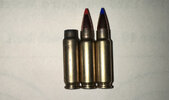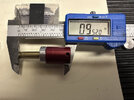nettlle
Contributing Member
Trying to figure out if I need one or not. Never used one. If my cases pass a case gauge and chamber easily why would one be needed?
It’s to keep from having case head separations, and that’s it IMHO.It's advertised to extend case life. What dimensions would one be trying to achieve and how would you adjust the die for it? Does a small base die cancel the adjustment option out?
If the Gentle Reader is going to simply full-length resize every case, of every manufacturer, of every work-hardened condition,a headspace comparator is not "needed" in any way for reloading ammunition for any type of firearm.
Well spoken. Something well worth considering.If the Gentle Reader is going to simply full-length resize every case, of every manufacturer, of every work-hardened condition,
of every spring-back tendency, for every gun -- and discard said cases after 'x' cycles ('x' being a number as small as 5-6), so be it.
If longer life is desired -- with some engineering "feel" as to most efficient headspace -- for any given gun/case manufacturer,
condition (et al) -- I do recommend disciplined use of the comparator checking setting up of the die.
We may have a diverging concept here.... that gun is very hard or brass and minimizing brass movements will help, but it's not a one stop shop for lifetimeI am banging away with a 308 M1A and have read that brass life is only 3-4 reloads. Considering the gauge to possibly prolong brass life. Good 308 brass isn't cheap. When I bought the M1A I also bought a few hundred factory loads to hold me until I got 308 set up on the loading bench and to give me brass to start out with. I already have (4) reloads on some of this brass and I see no sign of case head separation. Maybe reload these a few more times to see if these rifles really are the case eaters folks say they are.
My 7.7 has a long chamber with a fat base. I'm picking up what your putting down, smoked expensive cases on the first firing.... you can try some advanced techniques like creating false shoulders on brand new cases, to blow the shoulder forward minimizing that first cycle death throw.Only trying to minimize the damage to the brass. Have not done well at minimizing movements by my use of a small base die.
If the Gentle Reader is going to simply full-length resize every case, of every manufacturer, of every work-hardened condition,
of every spring-back tendency, for every gun -- and discard said cases after 'x' cycles ('x' being a number as small as 5-6), so be it.
If longer life is desired -- with some engineering "feel" as to most efficient headspace -- for any given gun/case manufacturer,
condition (et al) -- I do recommend disciplined use of the comparator checking setting up of the die.
Would one be advantageous when loading for a rear locking bolt action? I have read cases do stretch more. The action in question is Carl Gustav 3000 (Sauer 80)
That's why it's called a comparator. Moreover, using the (average) fired case as reference point* for the comparator is exactly what I would recommend for individual rifle chambers, and is one of the easiest ways to set dies for a specified case manufacturer, work-hardness or springback conditions with any particular lot of cases -- or individual cases in mixed-lot/manufacturer sizing sessions.A comparator is not the only way, or even the best way, to set case dimensions specifically for individual rifles. It’s only a reference tool
post-postscript: In fact I do use the above in actual practice.false paradigm for comparison of use cases which has no bearing in actual practice.

I will disagree with you on this one.I own the Hornady tool - and multiple versions from multiple companies - but I rarely make use of them, and will say, with absolute certainty, a headspace comparator is not "needed" in any way for reloading ammunition for any type of firearm.


